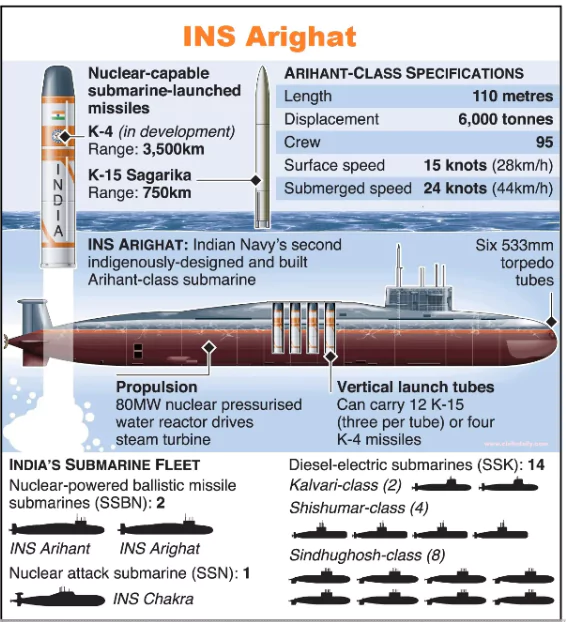India successfully tested a nuclear-capable ballistic missile with a range of approximately 3,500 km from the nuclear-powered submarine INS Arighaat in the Bay of Bengal.
Key Highlights of the Test
- The test was conducted off the coast of Visakhapatnam, marking a significant advancement in India’s nuclear deterrence and strategic capabilities.
- The missile tested was the K-4, which enhances India’s second-strike capability under its nuclear triad.
Enroll now for UPSC Online Classes

About INS Arighaat
- The INS Arighaat is India’s Second Indigenous Nuclear-Powered Ballistic Missile Submarine (S SBN) indigenously built nuclear-powered ballistic missile submarine, following the INS Arihant, its predecessor.
- It was constructed at the Indian Navy’s Ship Building Centre (SBC) in Visakhapatnam.
Features of INS Arighaat
- Nuclear Reactor Technology: Both the INS Arighaat and its predecessor, the INS Arihant, are powered by pressurized light-water nuclear reactors.
- This allows them to remain submerged for extended periods compared to conventional diesel-electric submarines, which must surface frequently to recharge their batteries.
K-4 Missile
- Type: Intermediate-range Submarine-Launched Ballistic Missile (SLBM)
- Range: Approximately 3500 km
- Purpose: Nuclear deterrence and second-strike capability
- Development: Developed by the Defence Research and Development Organisation (DRDO)
- Deployment: Deployed on India’s Arihant-class nuclear-powered submarines
- Significance: Completes India’s nuclear triad, enhancing its strategic deterrence capabilities.
|
- Missile Capabilities: The submarine can carry:
- Four K-4 Submarine-Launched Ballistic Missiles (SLBMs), each with a range of over 3,500 kilometers.
- Alternatively, twelve K-15 SLBMs, capable of carrying conventional warheads with a range of around 750 kilometers.
- Speed and Submersion: On the surface, the submarine can achieve a maximum speed of 12–15 knots (22–28 km/h).
- When submerged, it can reach a higher speed of 24 knots (44 km/h), enhancing its stealth and maneuverability underwater.
Check Out UPSC NCERT Textbooks From PW Store
Significance of the Test
- Strengthening Nuclear Deterrence: Demonstrates India’s ability to deliver a second strike in case of a nuclear attack, bolstering its strategic capabilities.
- Advancement in SLBM Technology: The successful launch of the K-4 missile ensures India’s place among nations capable of deploying nuclear weapons from submarines.
- Boost to Indigenous Defense Technology: Highlights India’s advancements in building nuclear-powered submarines and long-range missile systems indigenously.
Additional Reading: Types of Missiles
![]() 29 Nov 2024
29 Nov 2024

